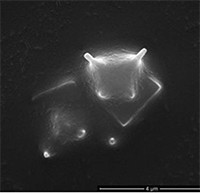Online surveys made by a British daily that frequently publishes articles on UFO sightings and claims of alien life show that its readers are divided when it comes to that controversial subject. Usually, half believe, while the other half think otherwise.
To prove that there is alien life, scientists point to a bull-shaped particle, which are small pieces of debris floating in space captured by super-powerful magnets, as proof. They insist the particle is a complete living entity, reports Express.
The University of Buckingham Centre for Astrobiology launched an exploratory project in Derbyshire that deployed powerful magnets into the stratosphere. The image captured was a crystal of salt that formed the image of a horned creature.
"The picture illustrates what we believe to be alien microbes high up in the stratosphere," explains Professor Milton Wainwright from the university. His team believes that the microbes are from space arriving into Earth. However, critics dismissed their discovery. The professor insists that their critics have not provided a viable alternative to their peer-reviewed work.
Wainwright said that the particle contain rare elements such as dysprosium, lutetium, neodymium and niobium. They found it about 30 kilometers close to the stratosphere. He points out, "These particle masses are too big to have been carried up from Earth, and like the alien life forms we find, must be incoming to Earth from space."
Besides Wainwright, other scientists who believe in the existence of alien life include Chandra Wickramashinge, an astrobiologist, and Gensuke Tokoro. From the Institute of Panspermia and Astroeconomics of Japan, Tokoro wrote a separate study on the existence of extraterrestrial microbial life.
In January, Wainwright announced that his team found a microscopic metal globe in dust and particulate matter collected from the stratosphere. He described its structure as made from the metals titanium and vanadium. He added a "gooey" biological liquid was oozing from its center.



























